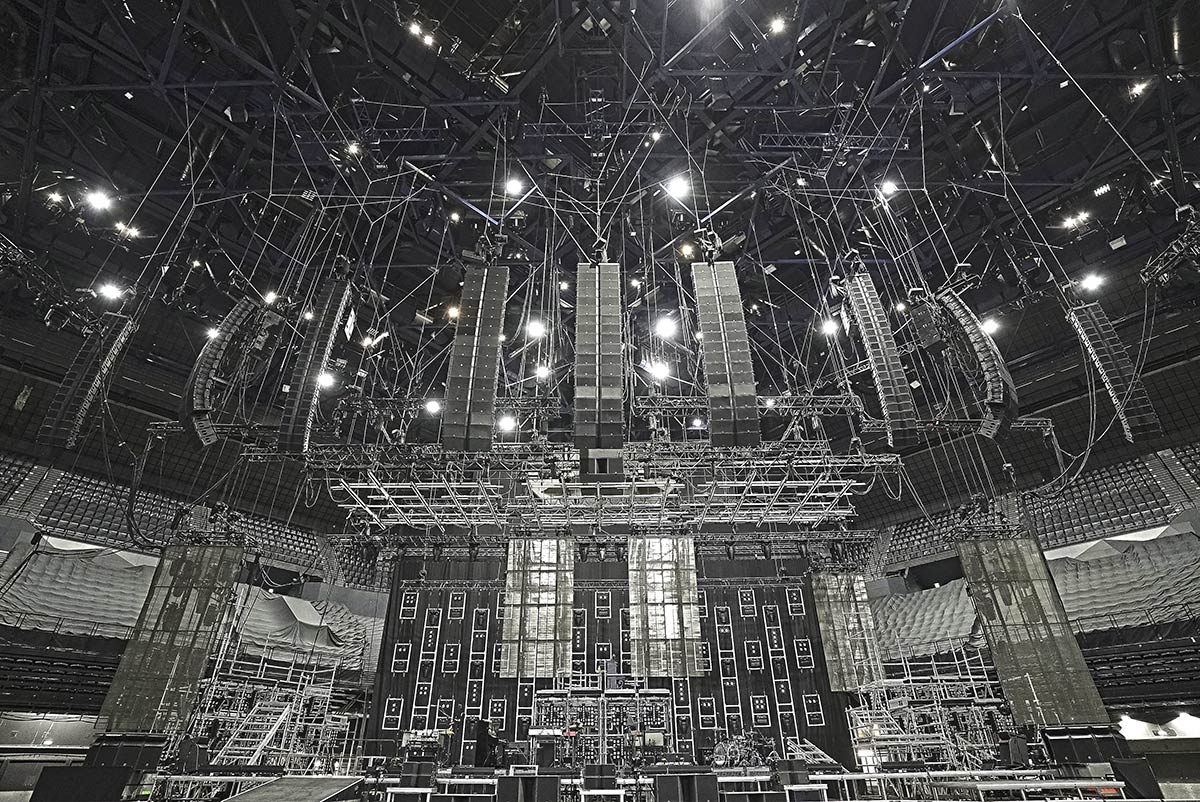The sold-out tour of Lomepal came to a triumphant culmination at the Accor Arena in Paris, with three exceptional concerts. An immense audience, singing along to the French rapper’s every hit, created such a close bond that the artist was overwhelmed by moments of intense intimacy.
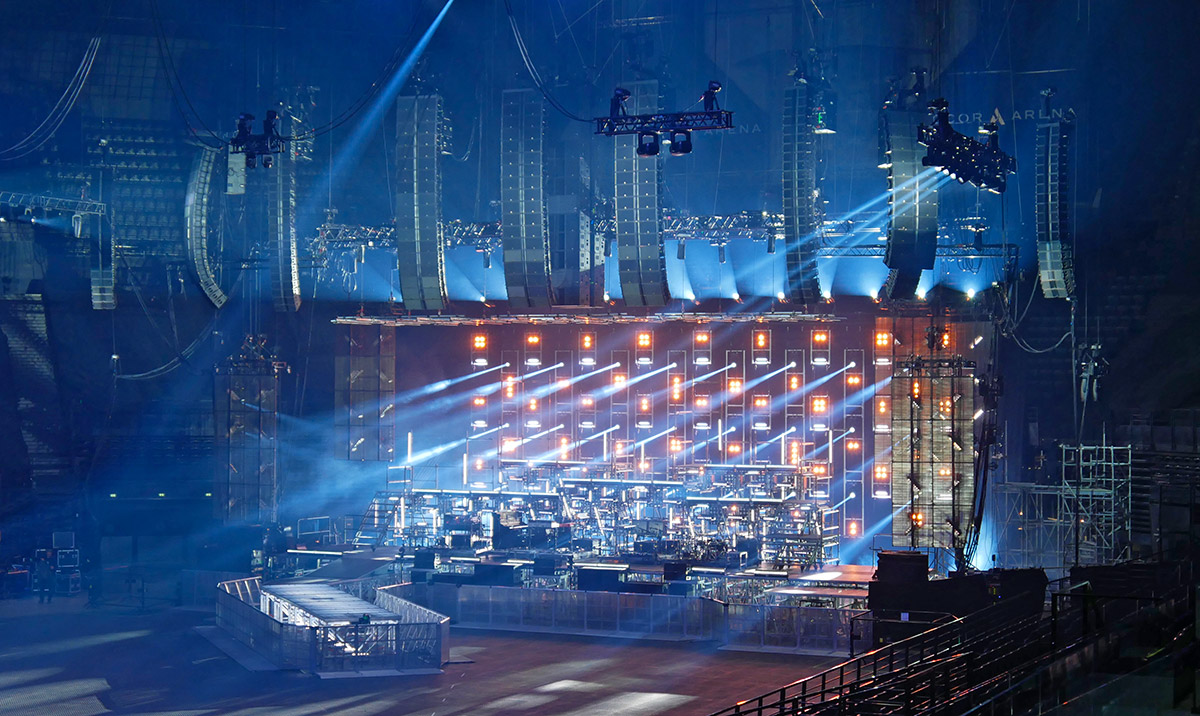
The technical side of things was also outstanding, with an immersive L-ISA sound system used throughout the tour, which was justifiably exaggerated for its three Paris dates, with a total of 216 L-Acoustics enclosures, 144 of which in the main front arrays to cover the entire Arena without any delays.
The view of the system is impressive, as is the sound. Let’s take a closer look at the technology provided by Melpomen B-Live (L-ISA) and Don’t Give up (mixers and backline), with Vladimir Coulibre, Etienne Tisserand, Sylvain de Barbeyrac and Manu Mouton.
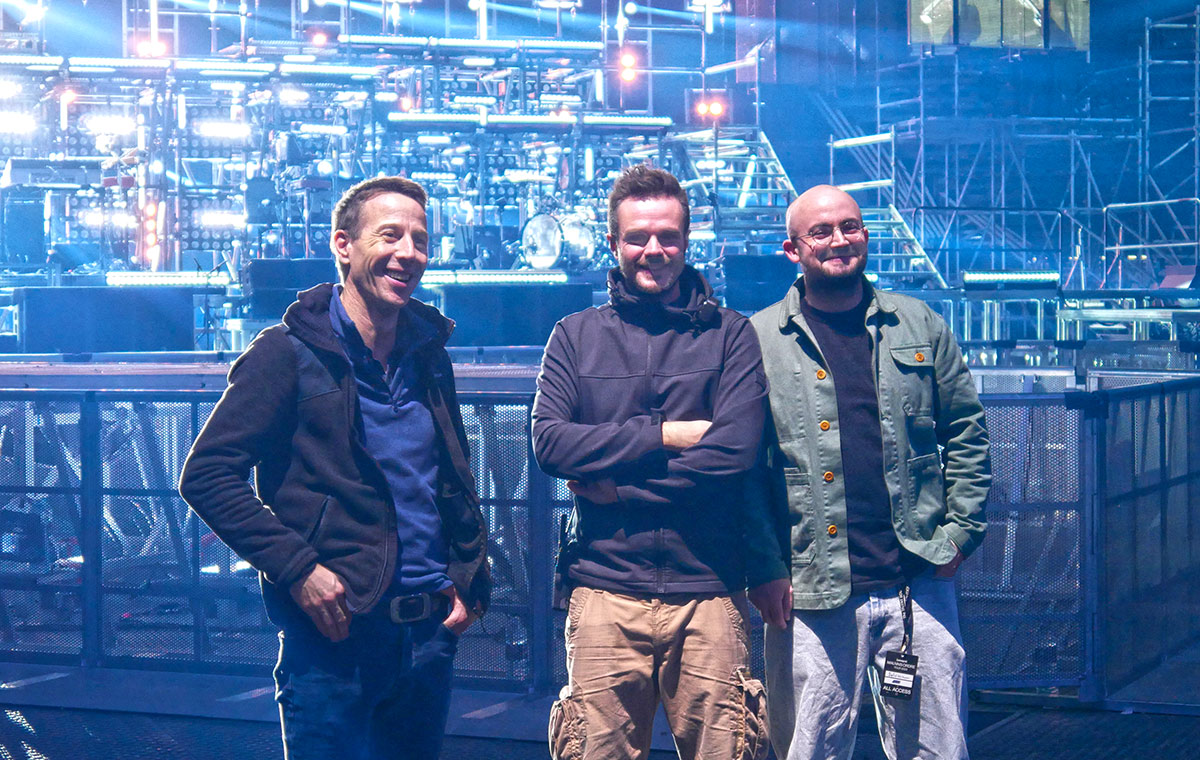
SLU : The L-ISA system we are about to look at is identical to the one used on the entire tour?
Vladimir Coulibre : The L-ISA configuration is the same for all the concerts on the tour, except for the festivals. It allows us to provide sound for all the venues without using any delays. Here at the Accor Arena, the only parameter that changes is the number of speakers used in each array because we have to throw out to 105 m. The Accor Arena is just another venue and there’s no reason to change the setup. We’ve just made the necessary additions to handle its depth.
SLU : Can you give us a run-down of the L-ISA system used here?
Vladimir Coulibre : : In a L-ISA system, we have the main frontal arrays of the Scene system, which corresponds more or less to the performance area (of the group), and the Extensions, which represent the expansion of the panorama. Here we have a FoH configuration of five Scene arrays, plus one Extension on each side. That makes a total of seven arrays.
The three central arrays are each made up of 18 K2 loudspeakers, supplemented on each side by two arrays of 24 KARA IIs. At the ends, there are two arrays of 18 KARA IIs each. We round this off with 24 KS28 subwoofers in the centre, suspended at the rear, and the entire lower section, which we adapt to provide perfect sound coverage for the audience at the front of the stage.
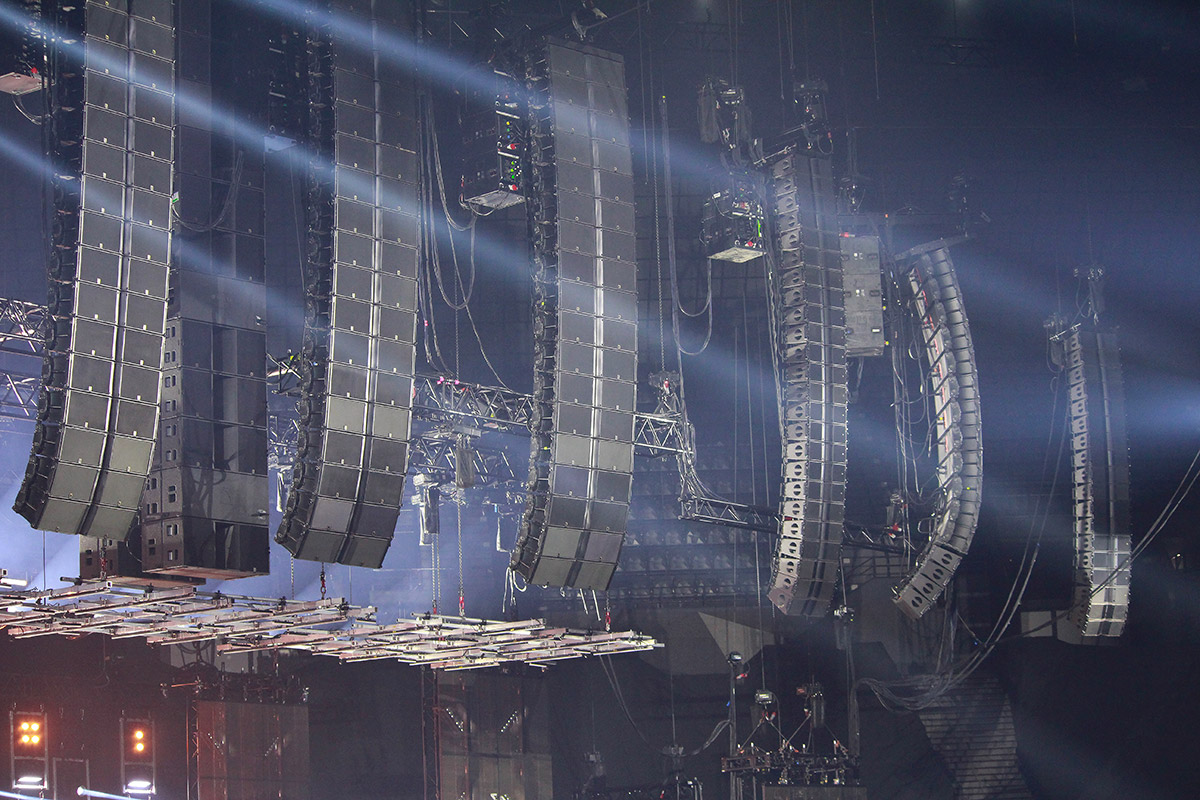
We also added subs on the floor but, because the stage is asymmetrical, we positioned them as best we could to deal with the scenography and visual constraints. All the subwoofers are cardioid.
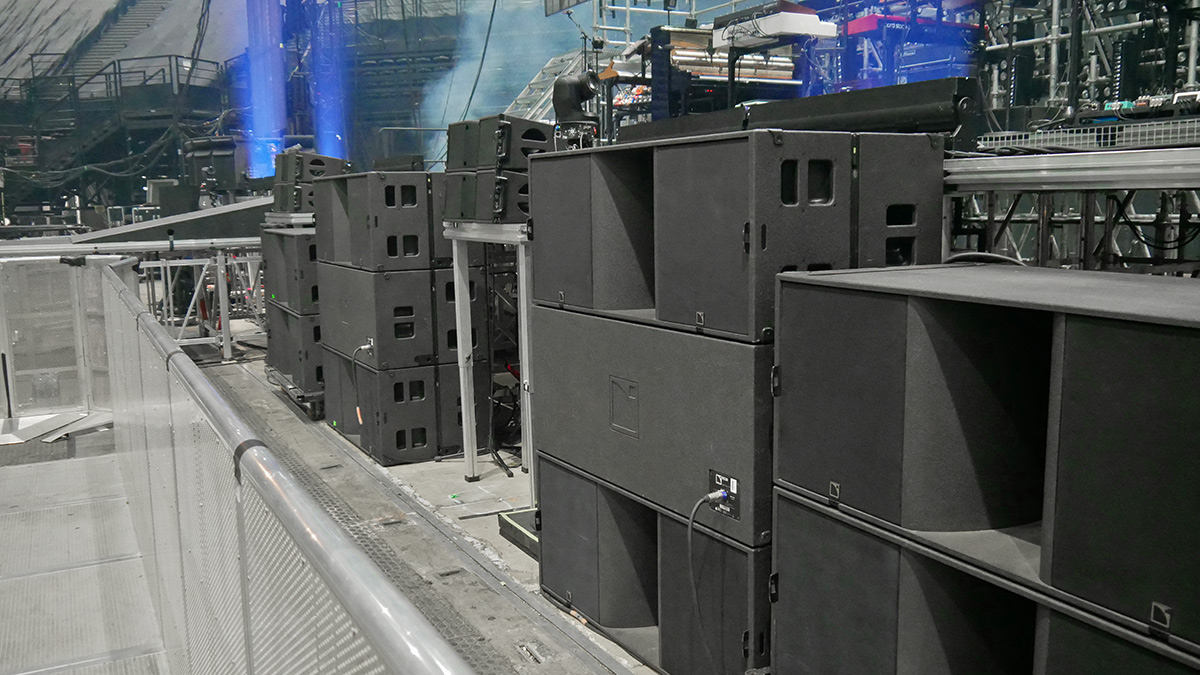
We then have KARA IIs as front-fills to cover the intersection of the K2s, and A15s on the side as classic stereo fills. The L-ISA processor drives all the speakers.
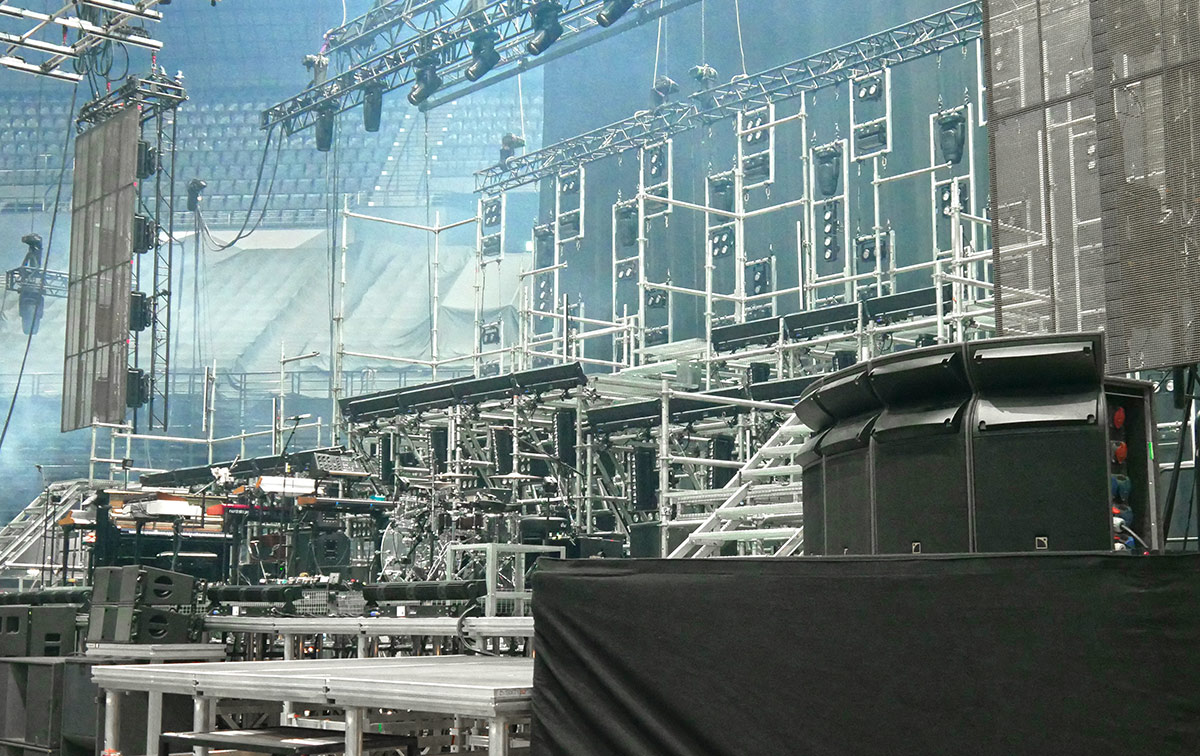
SLU : What was it like on the tour?
Vladimir Coulibre : On the tour we used the same kit, but scaled for Zenith-size arenas. We had a base of 12 K2s instead of the 18 K2s here at Bercy. Everything else was scaled accordingly.
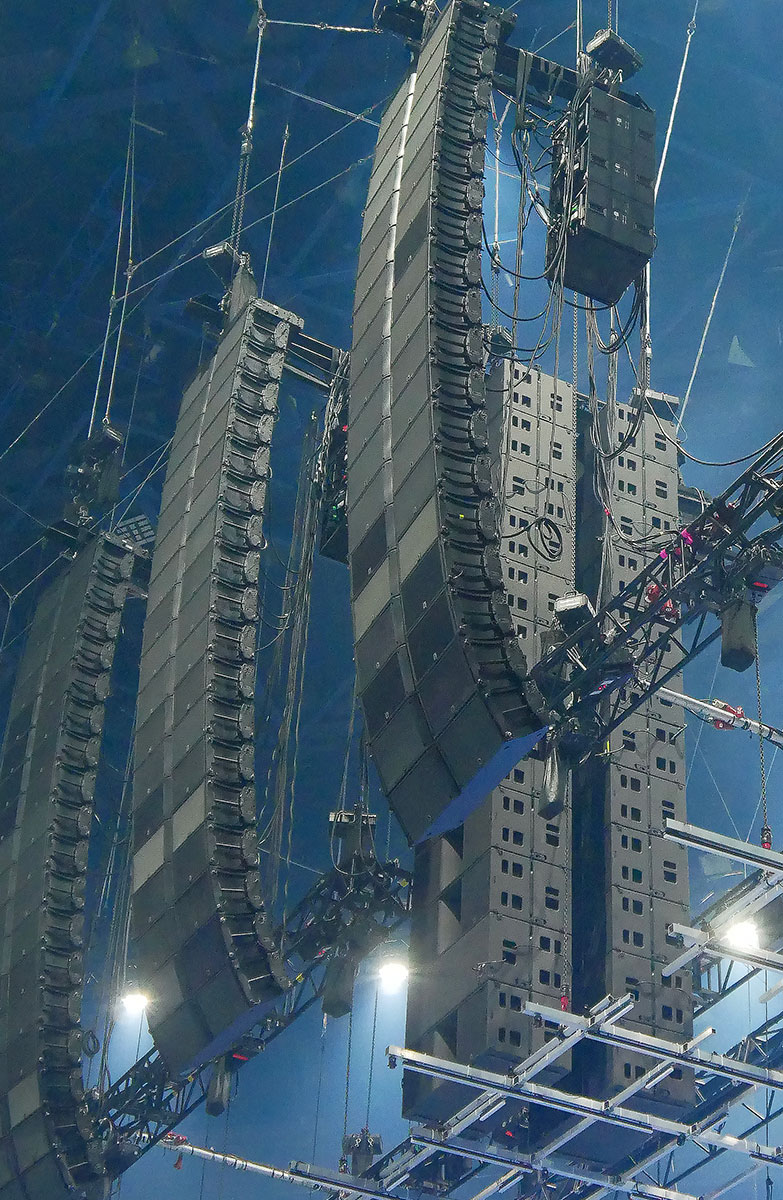
SLU : How do you determine the number of panorama extension arrays?
Vladimir Coulibre : Technically we can do whatever we want. We could go up to 11 arrays. The L-ISA system must be able to be used on a daily basis, to fit in with the economics of touring and the constraints of the installation. On this tour of arenas, we stopped at seven hangs, which is more than sufficient and effective.
SLU : Are the subwoofers always in the centre?
Vladimir Coulibre : It’s recommended to position them in the centre to improve the uniformity of the spatial effects, as well as the coupling with K2s. In rooms where it’s impossible to hang so many subs in the centre, I put them on the floor. They’re driven by a mono down-mix.
For this evening, those on the floor are controlled on an Aux send in L-ISA, to disconnect them from the flown subs and avoid a notch between the two sources at the top and bottom, or at least to make it as unnoticeable as possible.
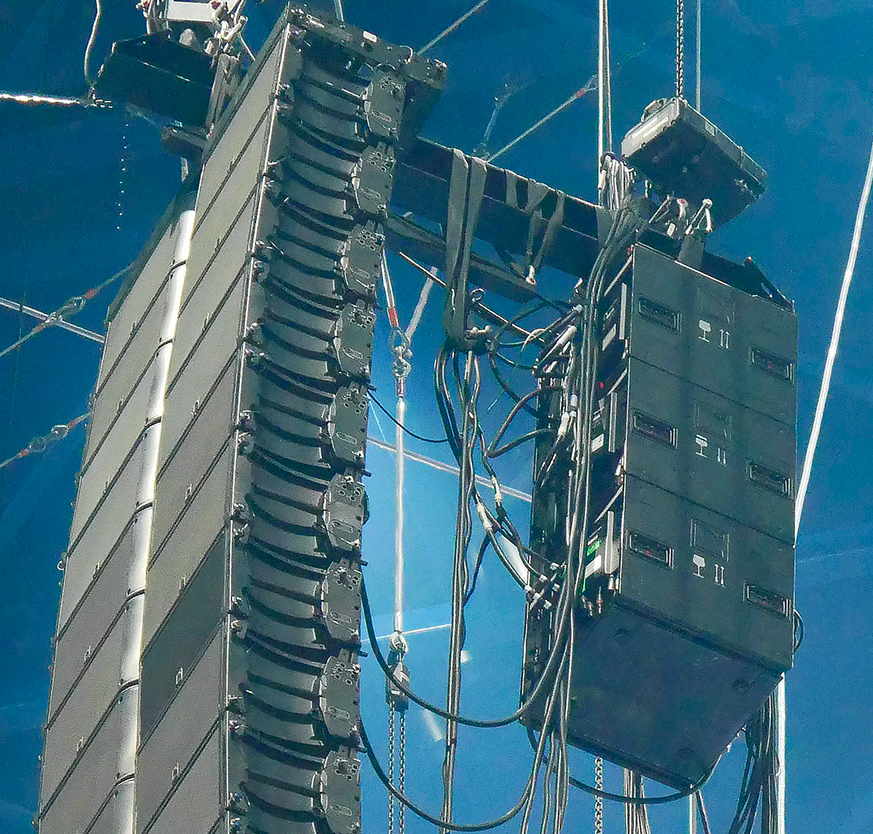
SLU : And the amp racks are flown, as well?
Vladimir Coulibre : Yes, we have the LA-RAKs flown behind each system to allow for greater height and reduce cabling. Each system receives a 32 A 3-phase power supply, primary and secondary AVB, AES cable for the analogue that provides a third layer of redundancy, as well as the laser. The AVB connection supplies the audio and control signals.
SLU : Are there no surround systems?
Vladimir Coulibre : To design an immersive 360° design, you must start from the constraints to determine what is possible. Using surround sound in a large room would mean installing some rather massive systems to exploit it or, if not, it would mean using it only for reproducing rather subtle sound elements. On this production, there was no reason for this, either artistically or in terms of cost, feasibility, or installation.
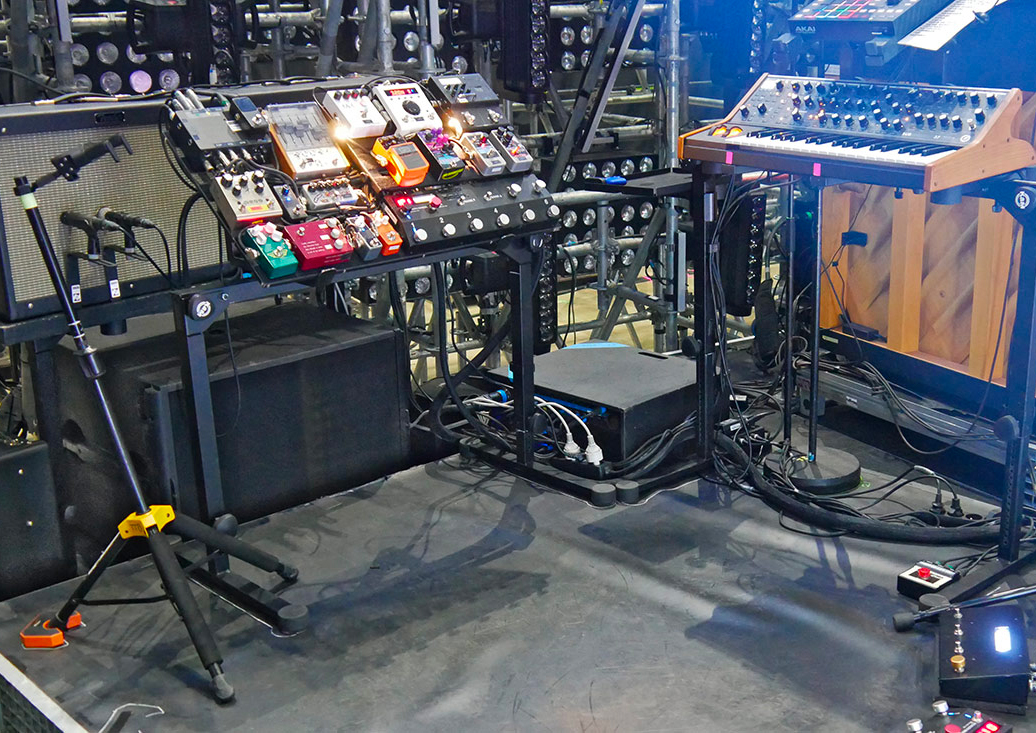
SLU : What about the monitors?
Vladimir Coulibre : On stage, there are two side-fills and each musician has a subwoofer, in addition to his IEM, to reinforce the presence. Monitors are positioned under the entire length of the thrust stage, allowing Lomepal to have a clear monitoring at the positions marked, when he removes an earphone. The IEM receivers are Wisycom.
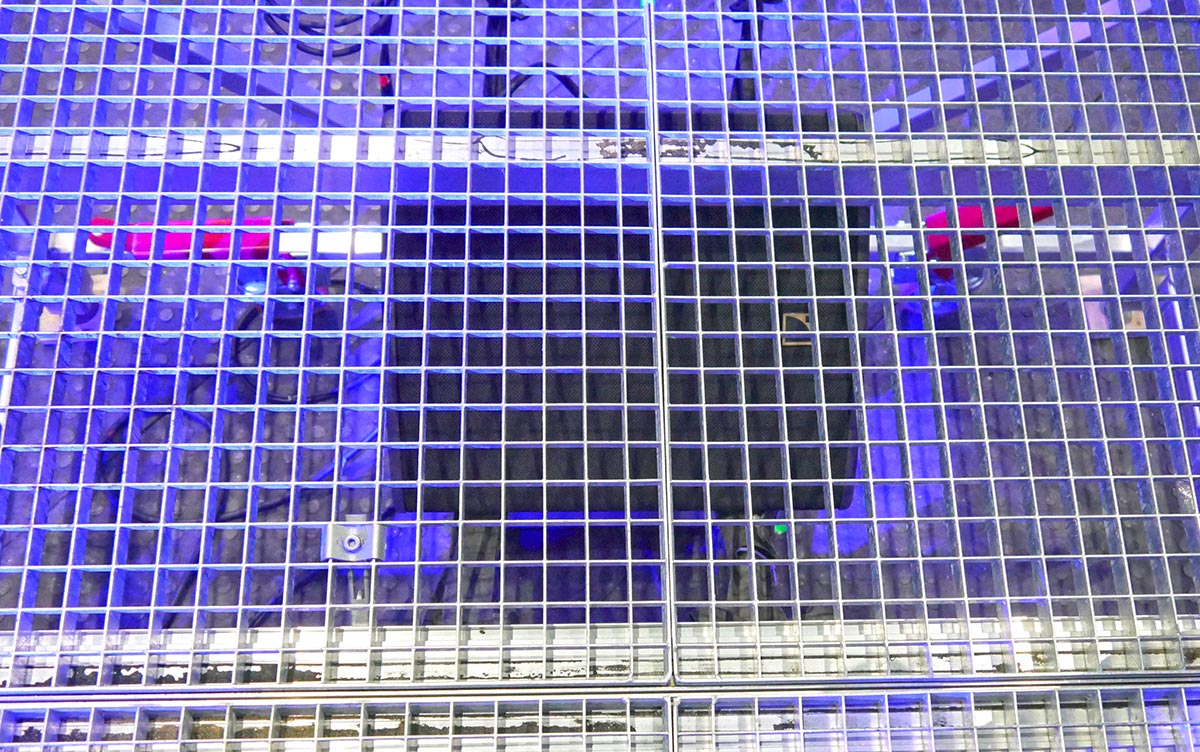
SLU : I can see some really nice microphones on stage!
Sylvain de Barbeyrac : The choice of microphones is a question of colour. I mix vintage types with very modern ones like DPA, Royer and Schoeps, to give the miking a studio feel.
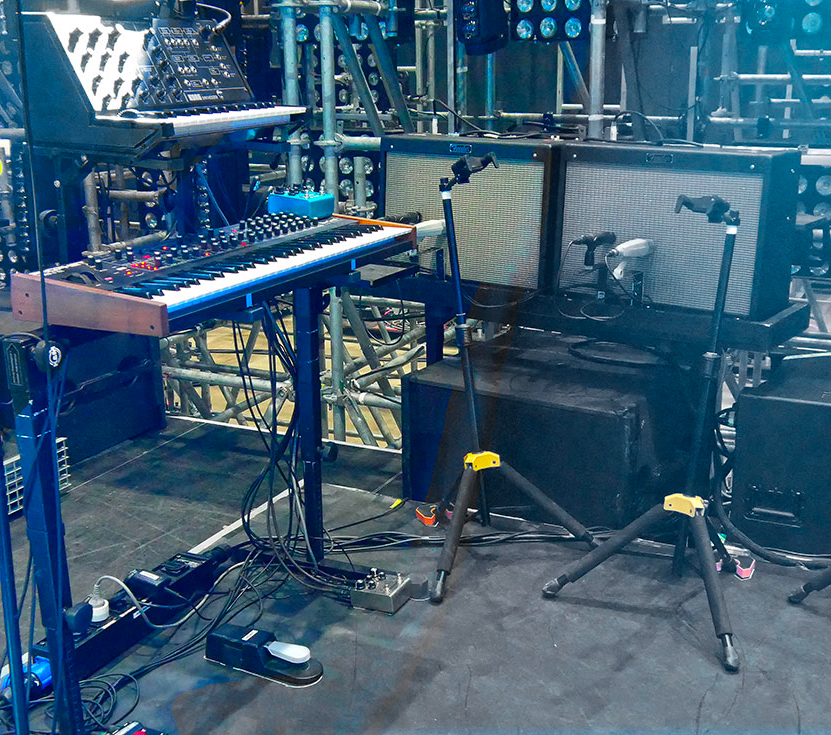
On the guitars, for example, there are always two mics per amp. That way I can change the sound whenever I want. I really like the old Sennheiser 421 and 441, but also the old series of Beyerdynamic mics like the M201 or the M160. There are six of them on stage.
All the wireless mics are Shure, with a KSM11 capsule on the lead vocals, which I run through a Rupert Neve Shelford channel strip located in monitor world, so that we all get the same sound. I process the vocals as little as possible and choose the right capsule to get the right sound.
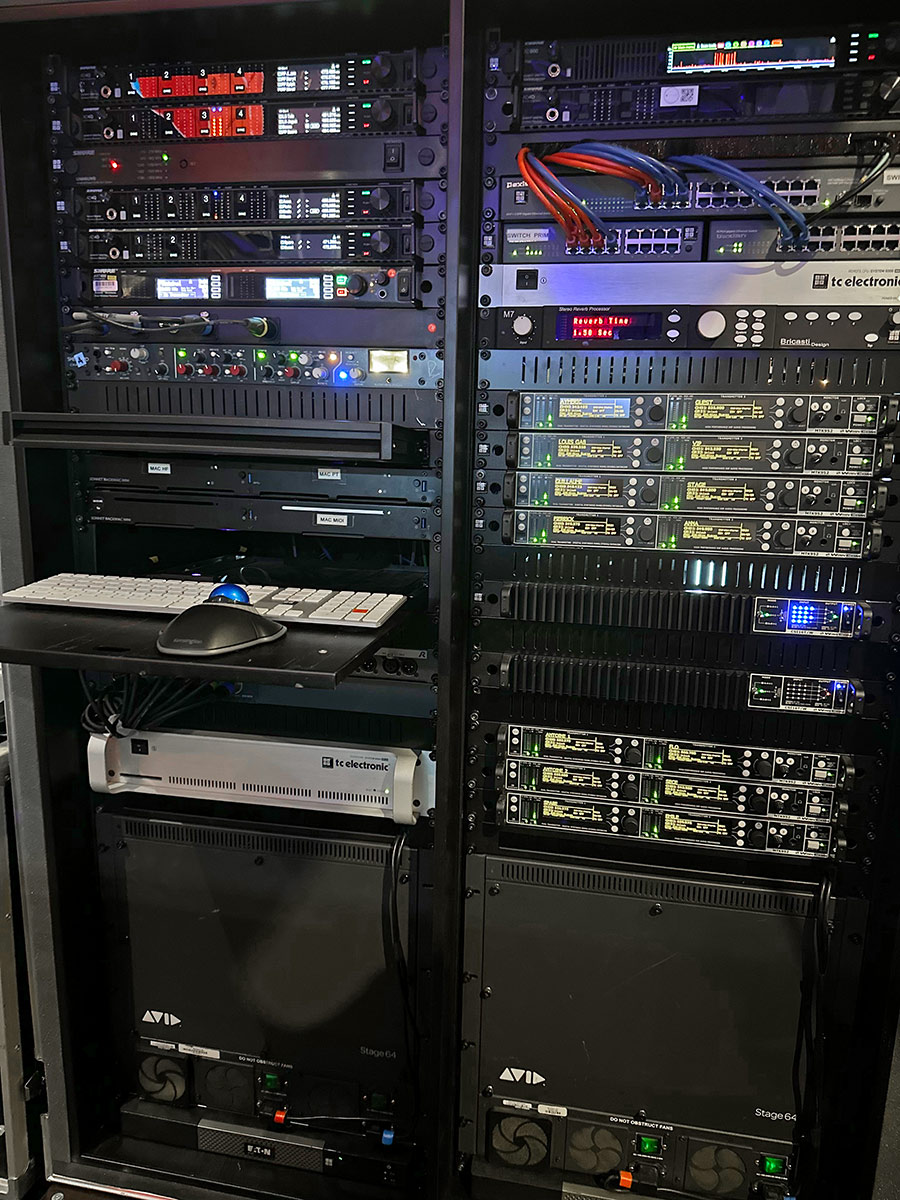
However, new tools such as the Soothe Live plugin from Oeksound have helped a lot to achieve a result very close to what I would have done in the studio. As this show is played entirely live without any computer or tracks, the way in which each source is captured is essential.
That’s why I use Rupert Neve Design RMP-D8 preamps on the synthesizers and 5211s on the drum mics.
SLU : What about the console with the L-ISA processor?
Sylvain de Barbeyrac : We’re coming out of the Avid Venue S6L console with three MADI streams to the L-ISA processor, which then sends the audio to the AVB-equipped amplified controllers.
We have a second processor as a spare, but it has never been needed. Each spatial object is driven post-fader for each channel, of which there are 96, as a direct output. I still have a few channels that I use for effects.
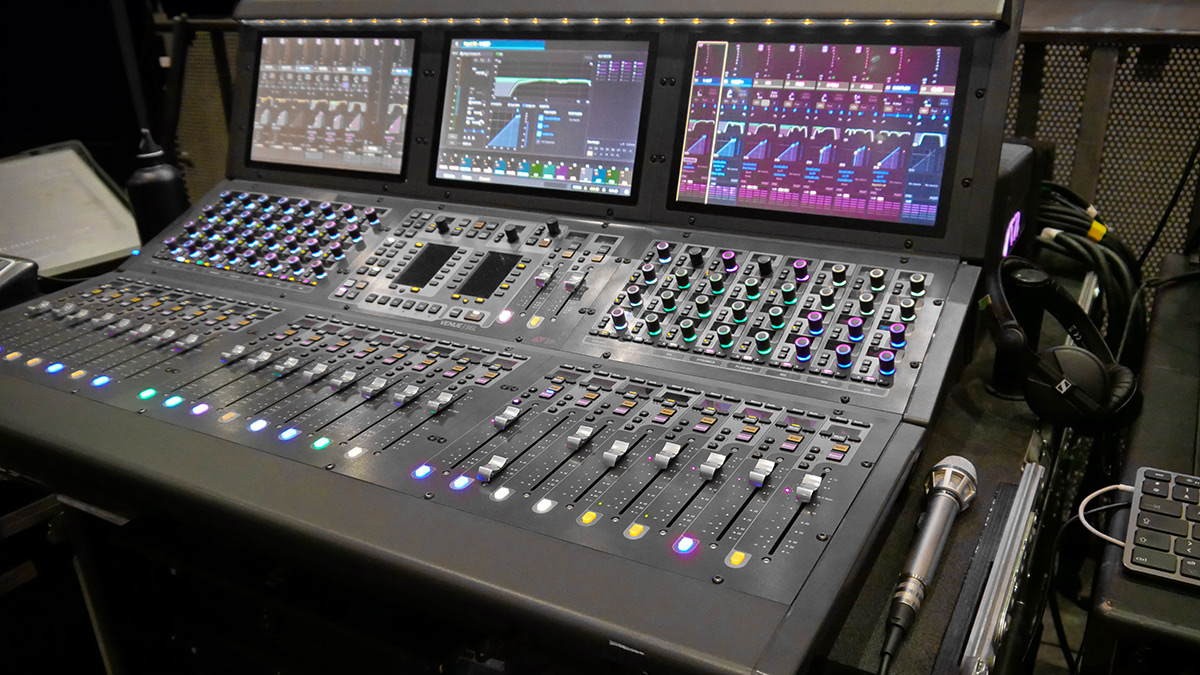
I set up the desk like a stereo mixing console, but without processing the groups and masters, keeping all the processing at the channel level, to enable me to mix at festivals where I don’t have L-ISA reinforcement, but a left/right. We played a total of 46 L-ISA dates in arenas with a full immersive set-up.
SLU : Is the L-ISA Controller software easy to use?
Vladimir Coulibre : Yes, that’s the idea. We have a ‘Soundscape’ tab that shows the object localisation. The dotted lines are the axes of the loudspeakers, and the white is the stage, the performance area, which we adjust so that the spatialisation is consistent with the reality of the set.
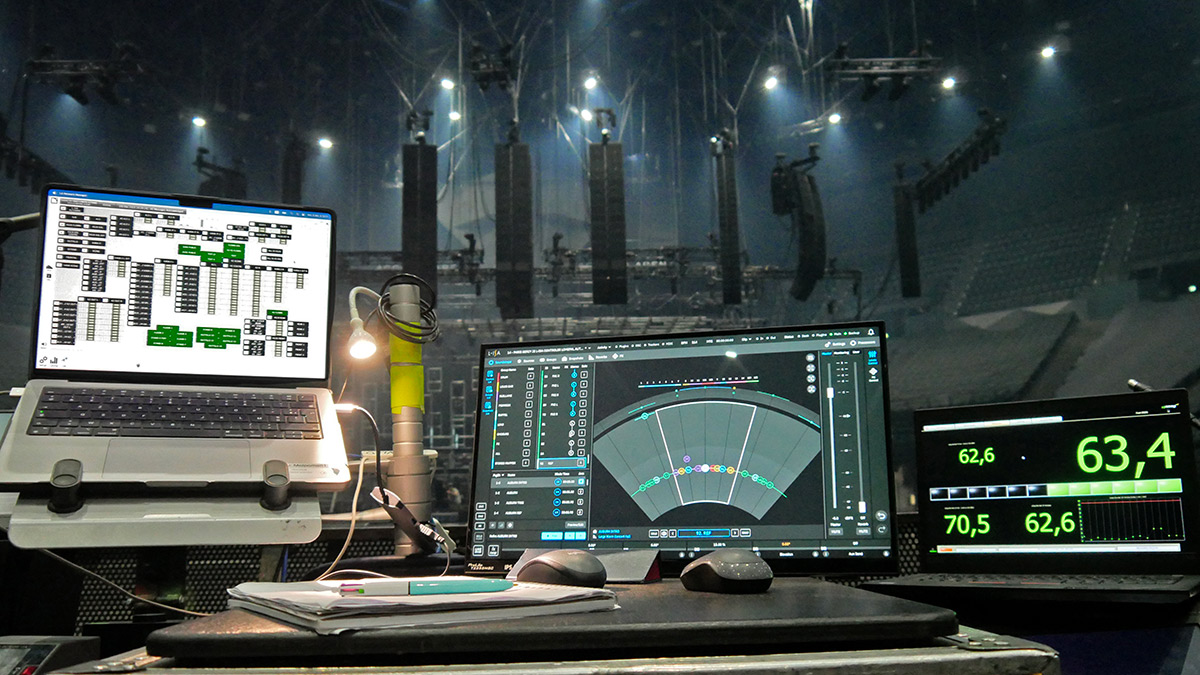
All the numbered points are objects, which we can group together if necessary. One tab gives access to the snapshots that Sylvain controls from the console.
There’s a lot of collaboration between the L-ISA operator and the sound engineer. I’ll assist him by moving the guitarist’s object, for example, when he comes down onto the lip of the stage. We could also control each object via a plug-in from the console, but since there are no sequences on this tour, manual sequencing of snapshots and tracking the musicians occasionally are more than enough.
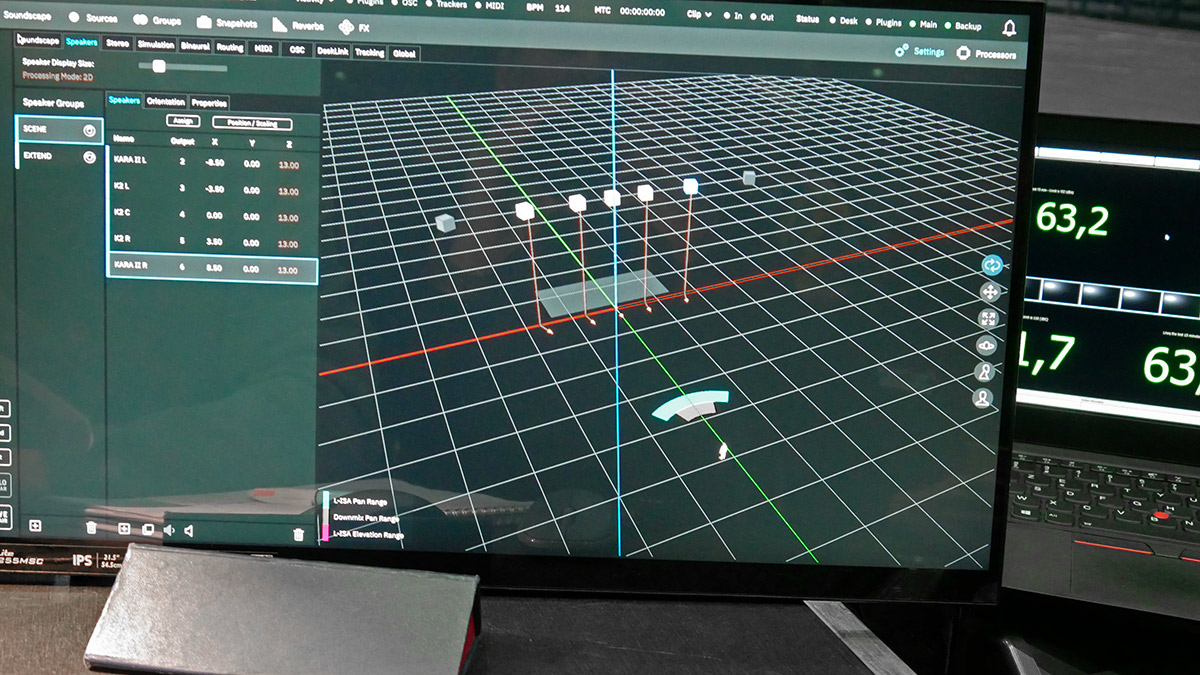
SLU : What algorithm does L-ISA use?
Vladimir Coulibre : The base algorithm is VBAP in the frontal system. A WFS base is also integrated for processing spatial fills for front-fill speakers, because VBAP is a multi-pan, which makes it more difficult to use over a very wide and shallow space.
SLU : What about other routings, not destined to the FoH?
Vladimir Coulibre : We don’t need to see all the mono, stereo or LCR feeds, because we don’t have to do worry about them. The L-ISA processor generates all those down-mixes without us having to do anything.
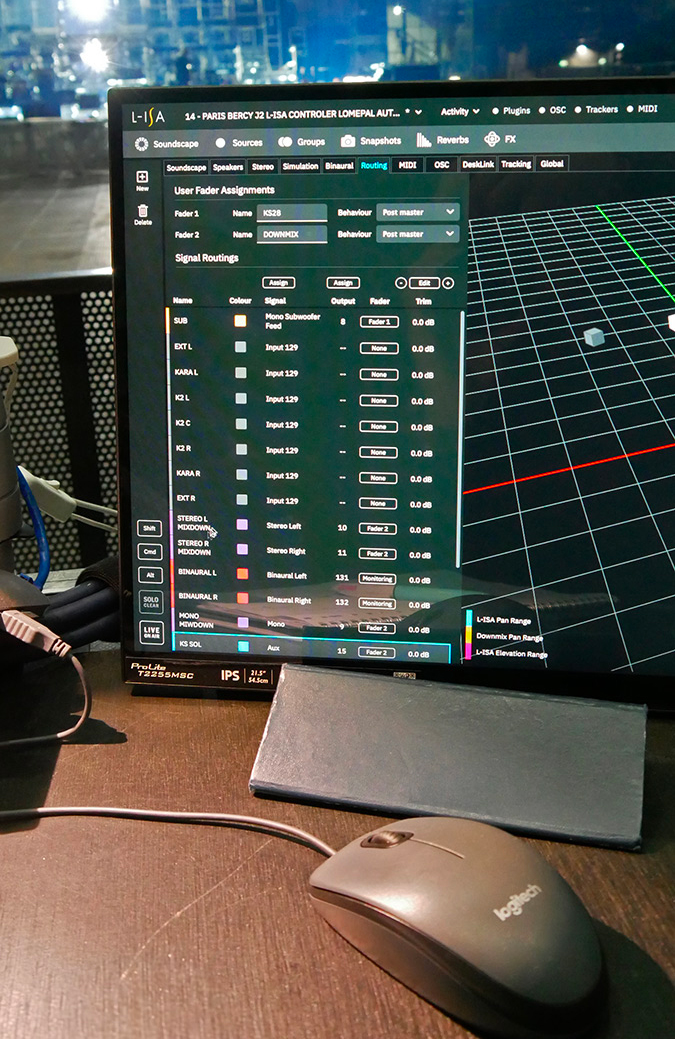
The floor subs which, as mentioned above, are on an Aux, and the front-fills are all in these down-mixes. We also have a Stereo Mapper that we use, for example, for the sound of the first part. It’s not managed as an object but goes directly into L-ISA processing. Everything is very simple for the operator.
SLU : I suppose this changes the way you mix?
Sylvain de Barbeyrac : Nothing gets summed in the console, so it’s very different from a conventional left/right. The L-ISA controller is very straightforward and, for me, quite easy to get the hang of. I’m not familiar with every aspect of the software, but what I need when I’m mixing is readily available, which means I can take control of objects during the mix and move them around. I make sure that the location of each source corresponds to the placement of the instruments and musicians on stage.
SLU : What parameters can you adjust on objects?
Vladimir Coulibre : The first is panning, which allows us to move the object from right to left. We can also move it further upstage instead of bringing the level down on the console. That way, it drops in amplitude and the high frequencies roll off appropriately, as well. Another function allows objects to be “snapped”.
As we’re working on a VBAP basis and in 2D, when you move an object, it’s in a maximum of two speakers with the Pan tool. The snap allows the object to be placed in a single speaker (a single array – ed. note). This is important and reflects L-Acoustics’ approach to immersive sound, which is based on the loudspeaker.
The design of the system plays a decisive role in the quality of the spatialised sound. This allows sound to be placed in a single array, to eliminate any interference and make maximum use of the system’s projection characteristics. This is what we do with Lomepal’s voice, which is snapped to the centre to ensure 100% intelligibility.
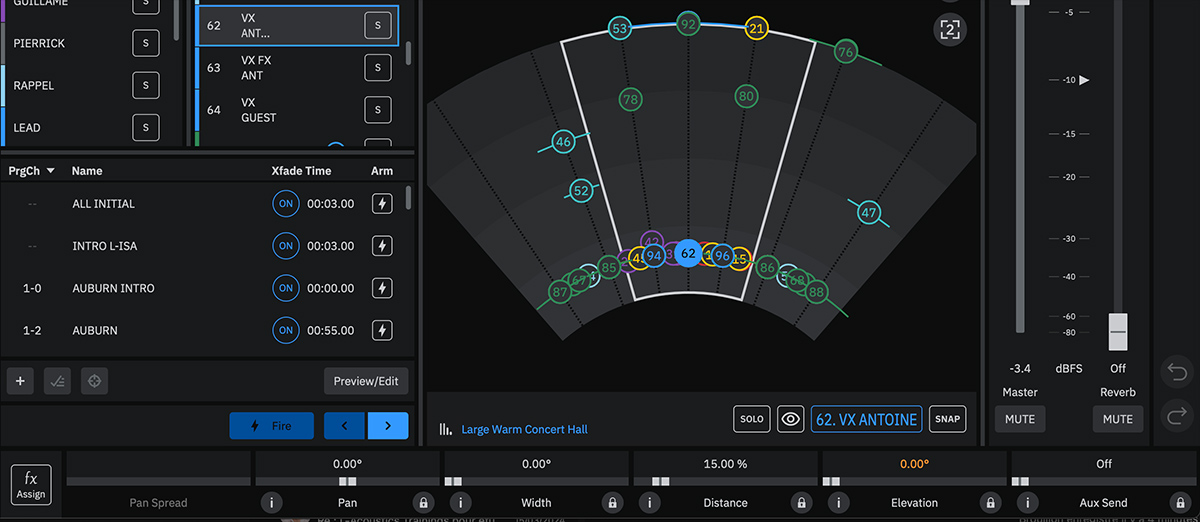
SLU : Can an object be output from more than two arrays?
Vladimir Coulibre : Two with the pan, one with snap. Then you can use the Width to ‘widen’ your panorama. The localisation is preserved because the energy is still focused on the object. This makes it a little more diffuse. Compared to WFS, the approach is different. In both cases, you must cover the audience and position the objects for better perception. With the use of Width, your object can then be spread over more than just two speaker systems.
SLU : If you snap an instrument to the far left, does everyone perceive it correctly?
Vladimir Coulibre : Yes, the frontal sound is basically immersive because the source objects are disconnected from one another, and the sound engineer gives the audience the possibility to decide to focus on one object or another. If I choose to look at the guitar, I focus on it and pick it up perfectly. In reality, immersive sound is not a one-way street created by the system, but also depends on the listener. It depends both on what you are playing and on what people are perceiving, depending on what they choose to look at.
It’s my job to ensure that the design and allocation between the arrays are as consistent as possible, in terms of how they are perceived by the audience. On the system, we optimise the inter-element splay angles (energy distribution), the horizontal directivity (mechanical modification and preset in the array) and the horizontal angle of the systems (the coverage between each system).
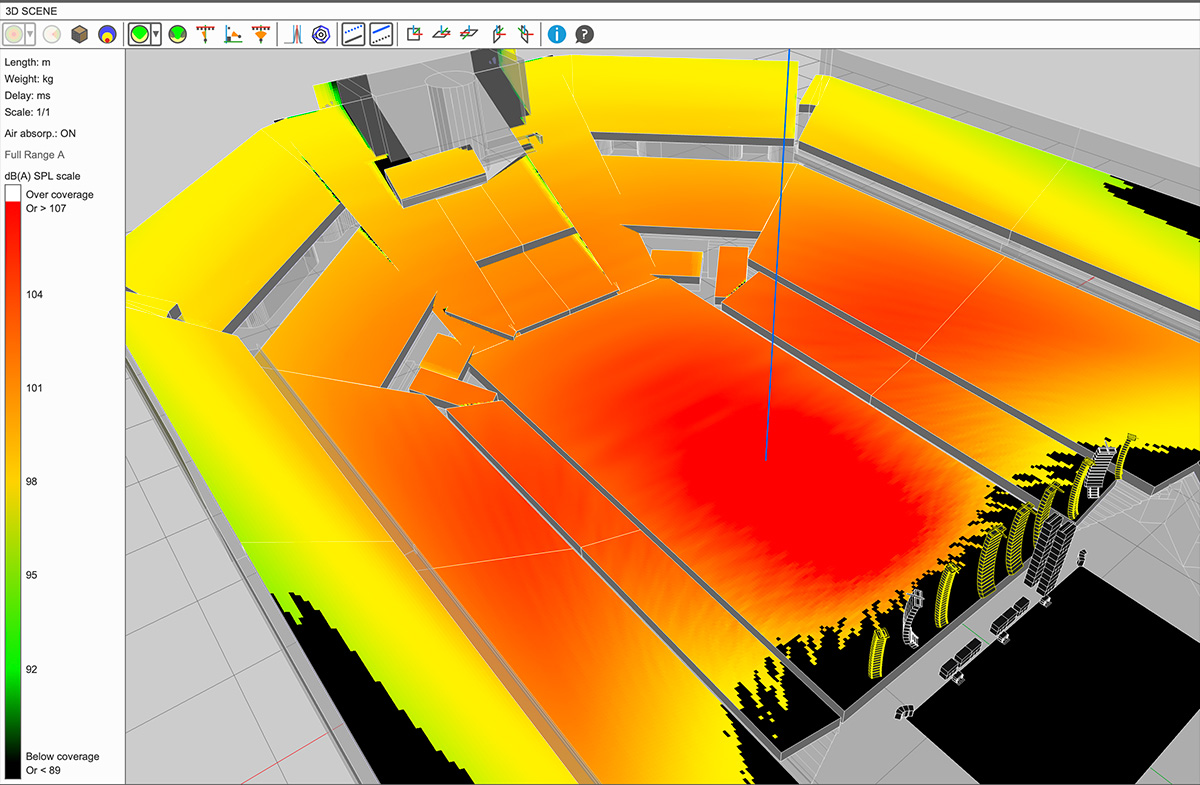
SLU : Are the front arrays not aligned in parallel?
Vladimir Coulibre : Well, no. The centre array is pointed straight, with a horizontal dispersion of 110°. Those next to it are slightly angled towards the centre. So when you’re on the right in the audience, you also benefit from the left-side system.
There is a natural relationship of distance to the object as an audience member. This may be minimal or a little more pronounced, depending on the design of the systems that we deploy and use in Soundvision.
SLU : Can Soundvision predict the quality of spatialisation?
Vladimir Coulibre : Yes, as well as providing all the classic information for L-Acoustics systems: coverage, SPL, frequency response, weight; it delivers an additional metric to define the L-ISA zone and the SPL that will be generated there.
Position data is then imported into the L-ISA Controller, which handles the concept of source position versus object position, and into the LA Network Manager for levels, delay and frequency management. They are separate because each has a specific job to do.
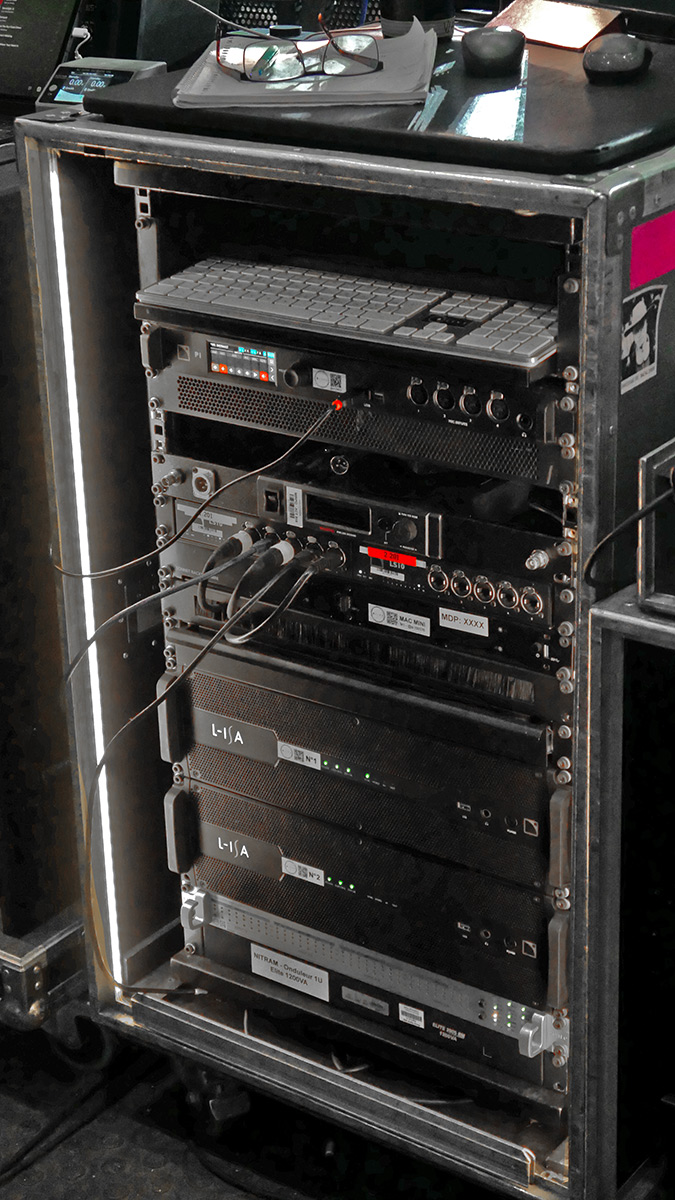
SLU : Are you the only ones using this speaker configuration?
Vladimir Coulibre : I think so, in terms of the system approach. It’s a speaker-based approach. But I don’t know all the solutions that exist. Immersion in the studio means you have a sweet spot.
Live, you have a performance, a system and an audience. It’s another way of looking at the system approach to spatialised sound. It’s also tied to the speakers we use.
SLU : Speaking of which, how do you set up a system like this?
Vladimir Coulibre : Like a conventional left/right. Temporal alignment, tonal balance and frequency smoothing. The concept is that I give Sylvain the same tonal balance every day in each room. A small room, fewer speakers; a large room, more speakers.
The P1 processor and M1 software are used to measure the acoustics. I place a microphone in the centre and test all the systems using sequenced measurements. Then I take multi-measurements to smooth out tonal variations between the K2s, KARAs and extensions. The delays that I configure are only for speakers outside the immersive zone.
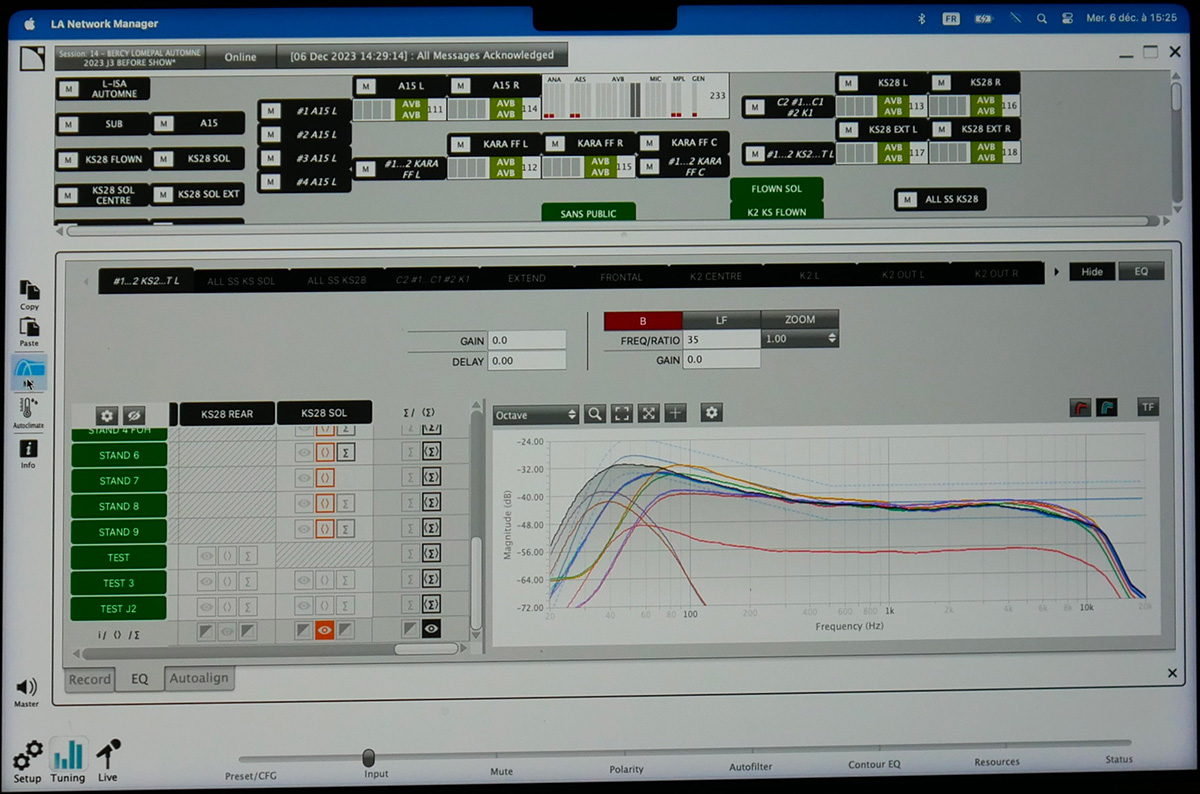
SLU : So, in this system, you don’t add any delay?
Vladimir Coulibre : In the main system, no. The aim is to have the least amount of interference and the least amount of distortion on the objects. When you place one between two loudspeakers, there’s bound to be some interference. But because the separation between the systems is so narrow, it’s hardly noticeable.
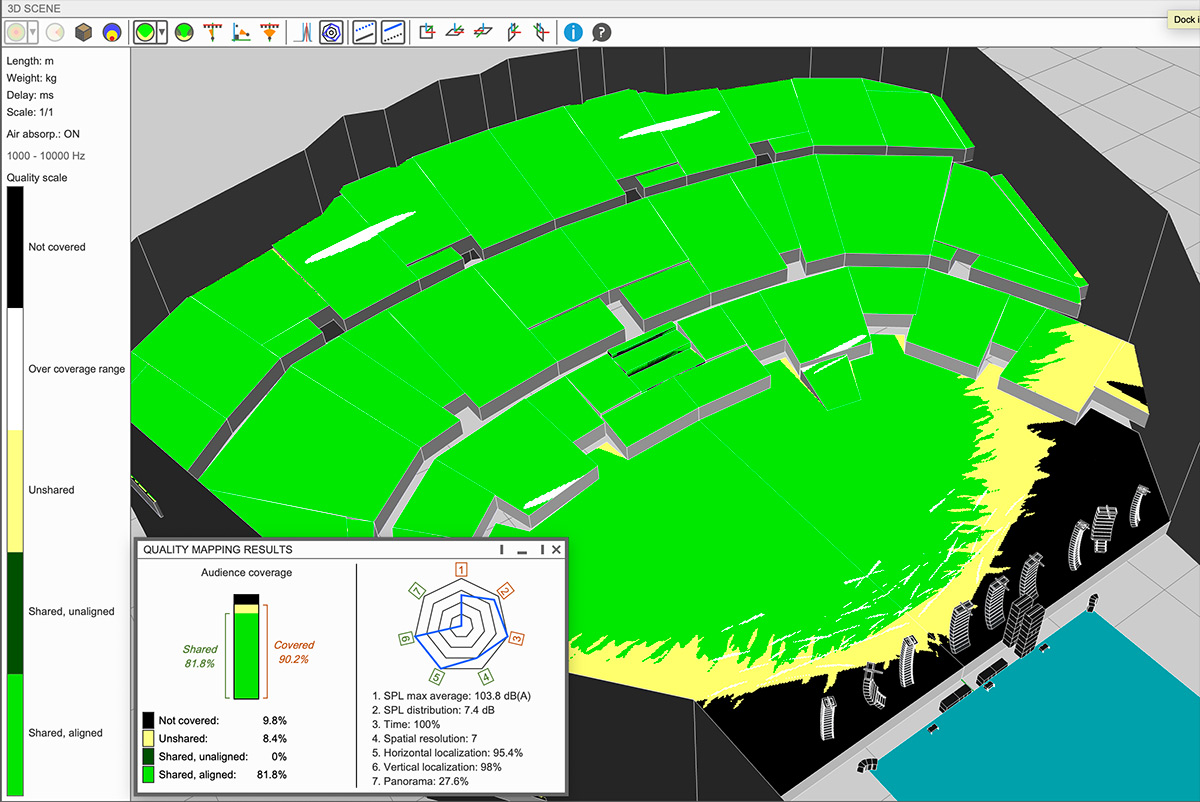
In fact, this is one of the criteria we use when we’re doing the design. We have templates and a software tool that gives us the ideal distances. In the various venues we visit, the distance between the systems remains the same. This is essential for the design to work and for Sylvain to always be able to recreate his mix.
SLU : What if you have to go into a room where the speakers have to be positioned differently?
Vladimir Coulibre : Going from a big venue to a theatre means using a different set-up, and you’ll have to change and rework your mix, that’s just the way it is. But what we want is consistency on the various dates. We haven’t changed anything except for the extensions, which we’ve sometimes moved closer together. L-ISA allows us to keep the same simple, smooth and practical setup.
SLU : What was the rationale behind the choice of L-ISA system on this tour?
Sylvain de Barbeyrac : We recorded the album live, with a configuration very similar to the setup we have today for this show; no computer and no sequences. The desire for greater precision and a better sound image quickly came to mind and I soon came up with the idea of offering a spatialised sound system.
I hoped to be able to reproduce the sound of the group and of each instrument as well as possible. I spoke about it with Vladimir and then Lomepal, and the production team came to hear a presentation of a L-ISA system at L-Acoustics. It all happened very quickly. The artist was convinced!
SLU : So the artist gives the green light?
Sylvain de Barbeyrac : Lomepal is very attentive to all the technical aspects of his work, including lighting, video and sound. He is also the co-producer of his show. With the L-ISA system, the voice always comes from the same direction and is always very intelligible, everywhere in the auditorium. That was one of the first things he noticed.
SLU : Was the decision already made?
Sylvain de Barbeyrac : Yes, knowing that we’d have to go from playing arenas to summer festivals and back to stereo. So I set up the console as if I were in stereo with groups and a master, and without any processing. I only process the channels. When we went to the festivals, the console was already ready and it worked really well.
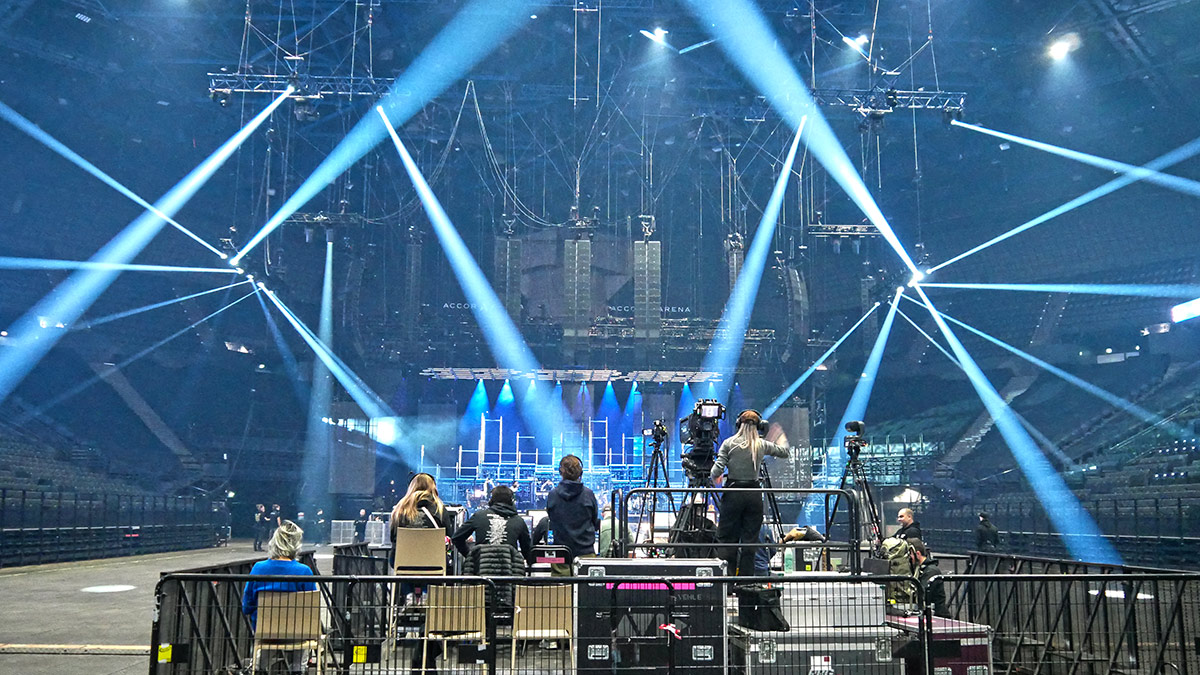
SLU : It must feel strange going from L-ISA to stereo
Sylvain de Barbeyrac : It was quite exciting actually. The set lists and the shows are different. Mixing in stereo during the summer made the mix evolve in a very positive direction. I memorised the console over the festivals and when we came back to the arenas, I was able to take advantage of it and improve my L-ISA mix.
SLU : Are there extra costs?
Vladimir Coulibre : Yes. Taking a step up in quality always comes at a price. We’re talking about 25% more. We need to consider how the audience will react to it. This increase is made all the more meaningful by the improved listening quality in 80% of the tier seating in the arenas. The improvement is enormous. Audiences come up to us and tell us that it sounds good, much better than in stereo.
SLU : Was this your first experience with immersive mixing?
Sylvain de Barbeyrac : Yes, I wasn’t familiar with the software, nor did I know how to run a live immersive system. What I did know was how to mix Dolby Atmos and 5.1 in the studio. In rehearsals we had a separate studio with a stereo system and a L-ISA system made up of smaller speakers, scaled to reproduce the same sound signature as the K2 + KS28 touring system. I recorded the musicians rehearsing in the studio next door, which allowed me to work on my own…
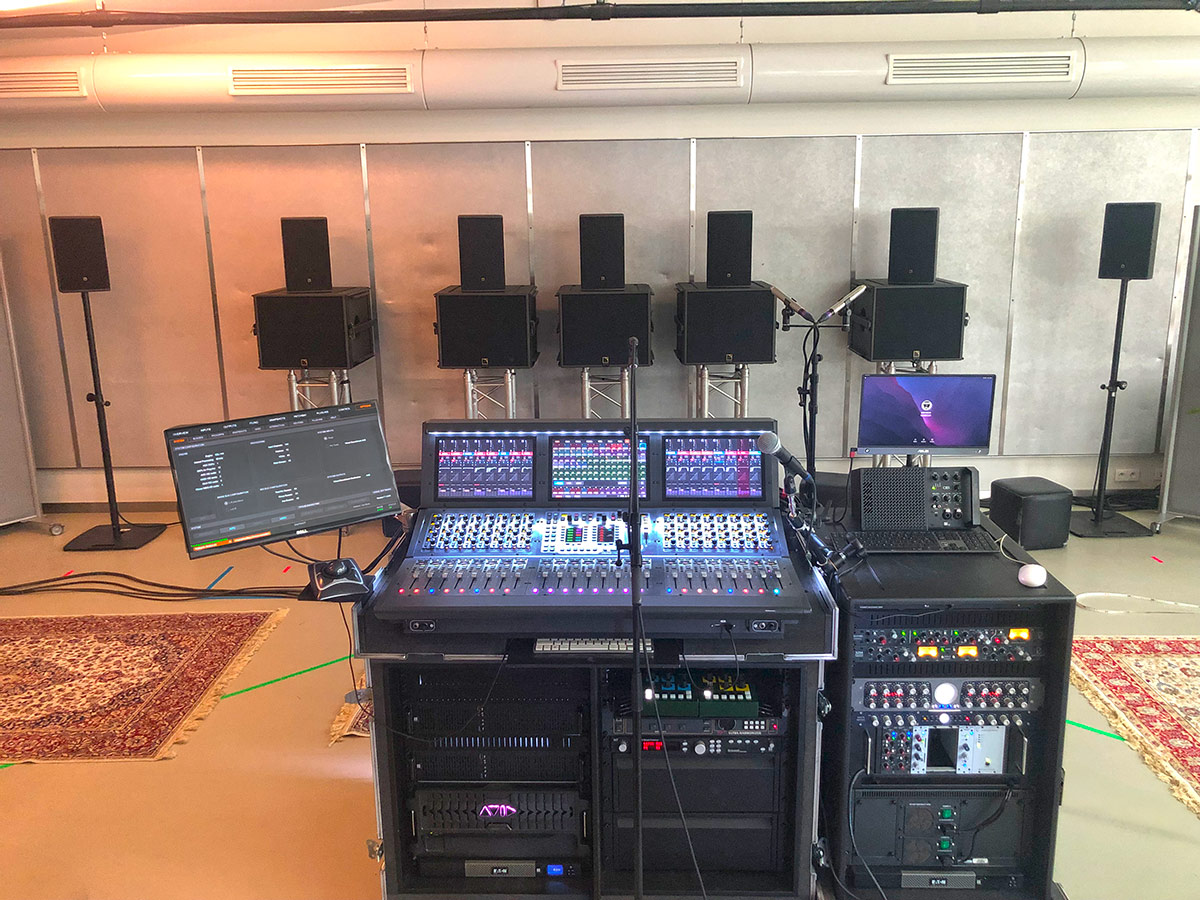
SLU : Were you already familiar with this venue? What’s the difference working with L-ISA?
Vladimir Coulibre : We’re achieving intelligibility, localisation, respect for timbre and panoramic possibilities that would otherwise be impossible. It’s a plus for the audience.
SLU : When you mix with L-ISA, does it change much on the console?
Sylvain de Barbeyrac : It really does. I don’t need to produce or remove elements that are stuck in a very busy sound image. For example, I don’t need to force the snare drum, which is often a left/right subject. Because here it’s placed in its own localised system, I don’t need to force it. In stereo, because you put a lot of things in the same place, you do a lot of equalisation and compression. In this case, I’ve only had to make slight corrections.
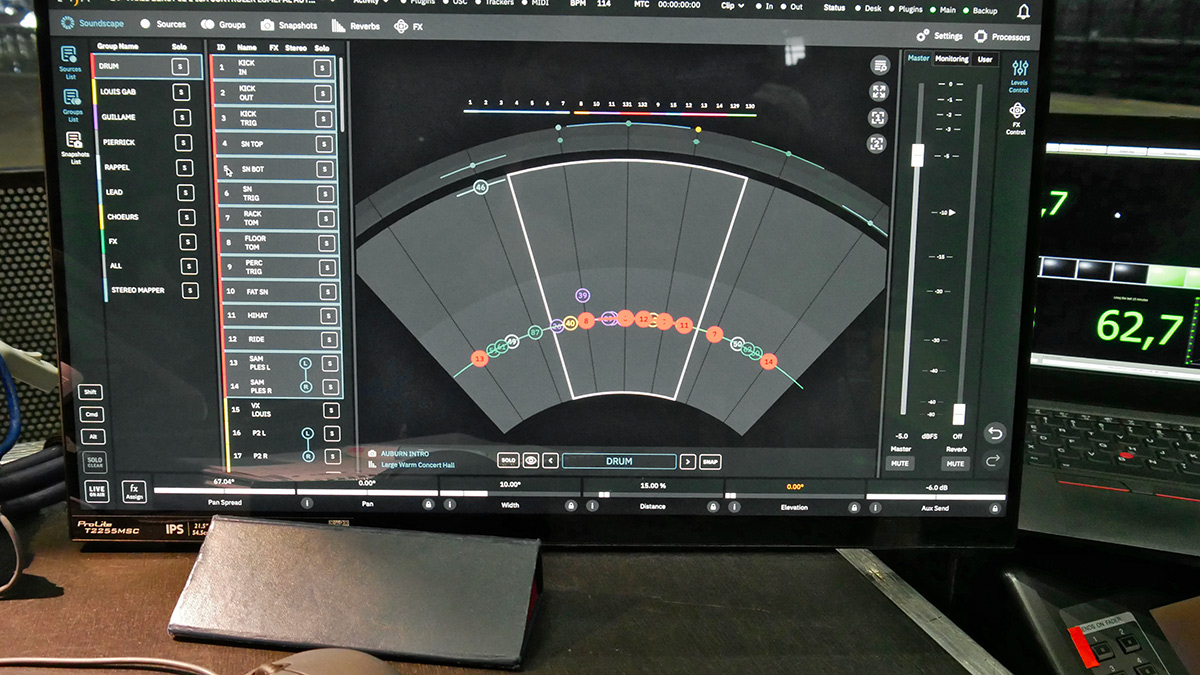
In hindsight, it’s easier to mix in L-ISA than in stereo, because I don’t tend to overproduce every element. I’m much more into naturalness, and if it doesn’t work like that, I question the choice of a microphone or the sound that’s causing a problem in the arrangement.
I’ve realised that stereo synths or guitars are also very effective in mono when it comes to localising them to a precise position, which translates into impressive clarity in the sound. This makes for a much finer mix.
SLU : What about the voice?
Sylvain de Barbeyrac : In my opinion, this is the system’s greatest asset, especially for this style of music where the lyrics must be perfectly intelligible. Wherever you are in the hall, it doesn’t get lost. Even in the upper stands at 105 m, it’s impressive, the voice is right there.
SLU : Are there any changes in the dynamic range?
Sylvain de Barbeyrac : The main difference is that I have to manage the dynamics of each element without using buses, but according to their individual needs of each. It’s very interesting and stimulating to have to change your habits, it sometimes makes you doubt, but you get out of a certain routine in the way you mix, and I really enjoyed that. I’ve learnt to listen differently, and I think that’s had an impact on the way I will mix concerts in stereo in the future.
SLU : …and greater freedom?
Sylvain de Barbeyrac : I have a VCA that handles everything except the vocals, and several times during the concert I’ll bring the whole mix down to a new level. It’s difficult to do that in stereo because I’d lose too much intelligibility. But in this case, it’s great to be able to use full dynamics. You can take the audience into a very intimate space and then grab them with a lot of dynamics.
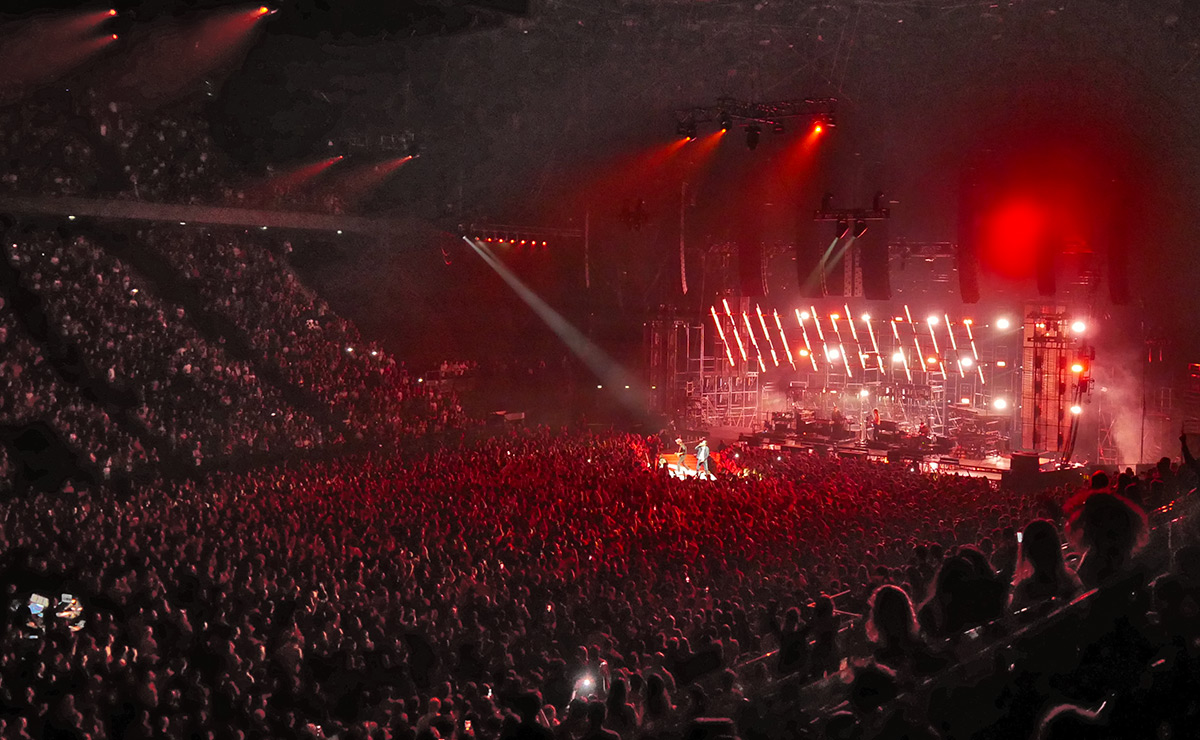
SLU : So it’s better for the sound engineer?
Sylvain de Barbeyrac : With this notion of focusing the instruments, it’s easy to pick up. I also used pan effects linked to the BPM, which are already prepared in the form of presets that can be edited. On some tracks the mix is rather rigid, on others it’s much more flexible.
I was a bit cautious at the start of the tour, I didn’t want to use the spectacular effects too much. But as the concerts went on, I realised that certain spatial effects made the mix come alive. It creates a nice depth throughout the show with special moments that create feeling.
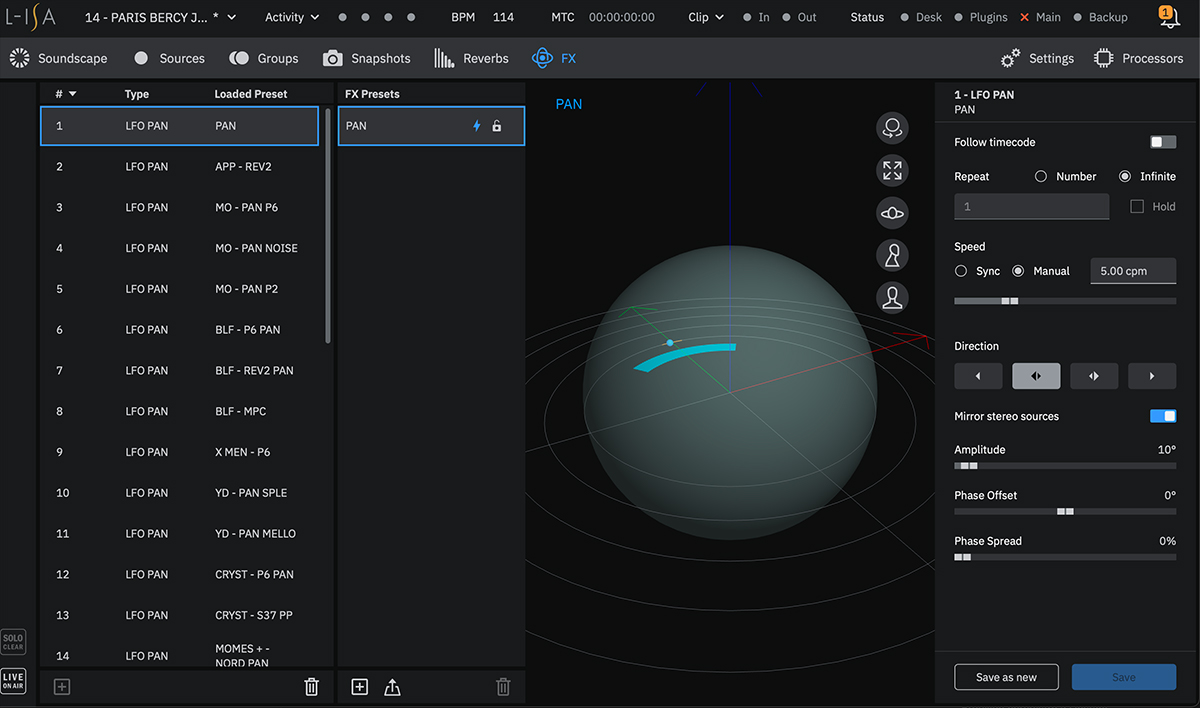
SLU : What do you do with the reverbs?
Sylvain de Barbeyrac : It’s the same as always. I haven’t changed the way I do my effects, except that I can hear them better. For Lomepal’s vocals, I’ve localised the reverb in his system. The same goes for the backing vocals. It’s very interesting because the effects of each don’t interfere with those of the others.
I place the larger, more impressive artistic effects in the Extension arrays. On the other hand, I don’t use the ‘Room Engine’ reverb of the L-ISA processor because, in arenas that are very resonant, it doesn’t lend itself to it. If we were in a theatre that was much more dead, we might consider it.
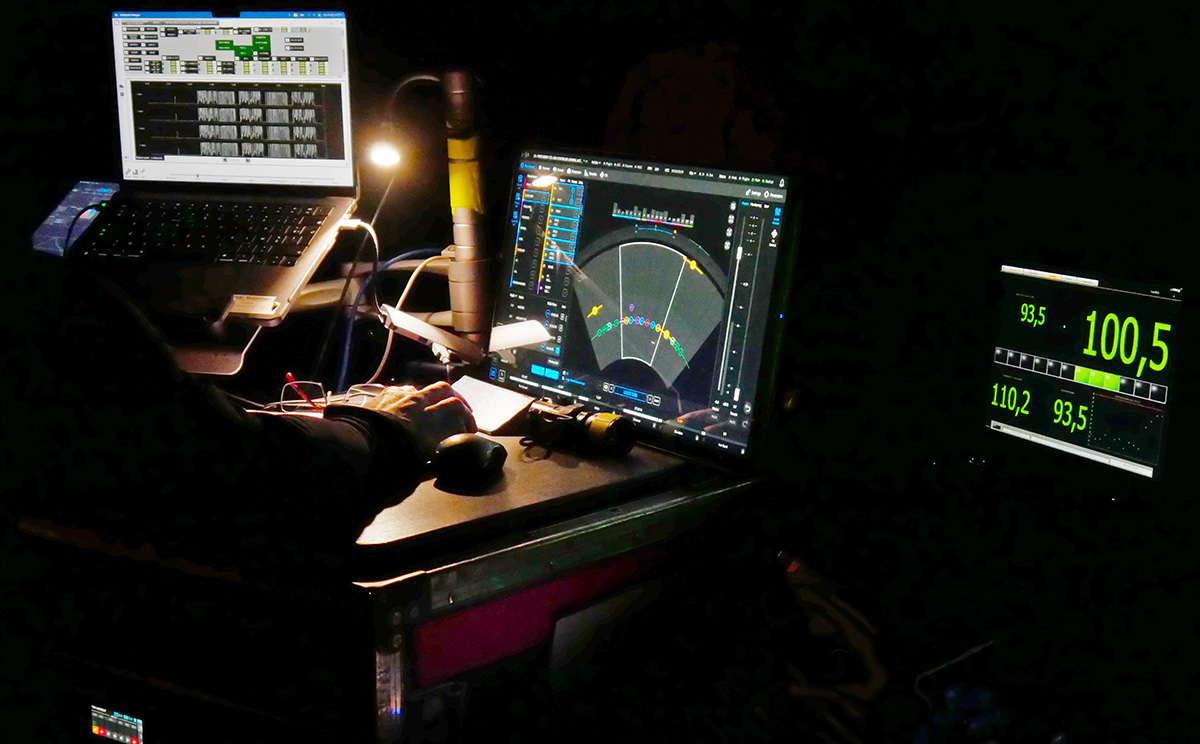
SLU : Does L-ISA allow you to get punch?
Vladimir Coulibre : The concept of dynamics is linked to the audio path (miking, console processing, loudspeakers) but also to temporality.
When you can put objects in any speaker, you maintain 100% temporal integrity. The listener receives everything perfectly well.
We don’t have a tool to measure this temporal integrity. But it remains very important. It’s this dynamic that gives this sensation. It’s a freedom to have this amount of energy that we rarely have in left/right. You gain a lot with L-ISA.
SLU : Could this improve the sound quality in certain venues?
Sylvain de Barbeyrac : Yes, we have fewer problems in those rooms that are known to be acoustically complicated. We also generate fewer problems using L-ISA, because we excite the room less in terms of level. In some rooms, the difference was really obvious. I don’t have to be loud to be intelligible.
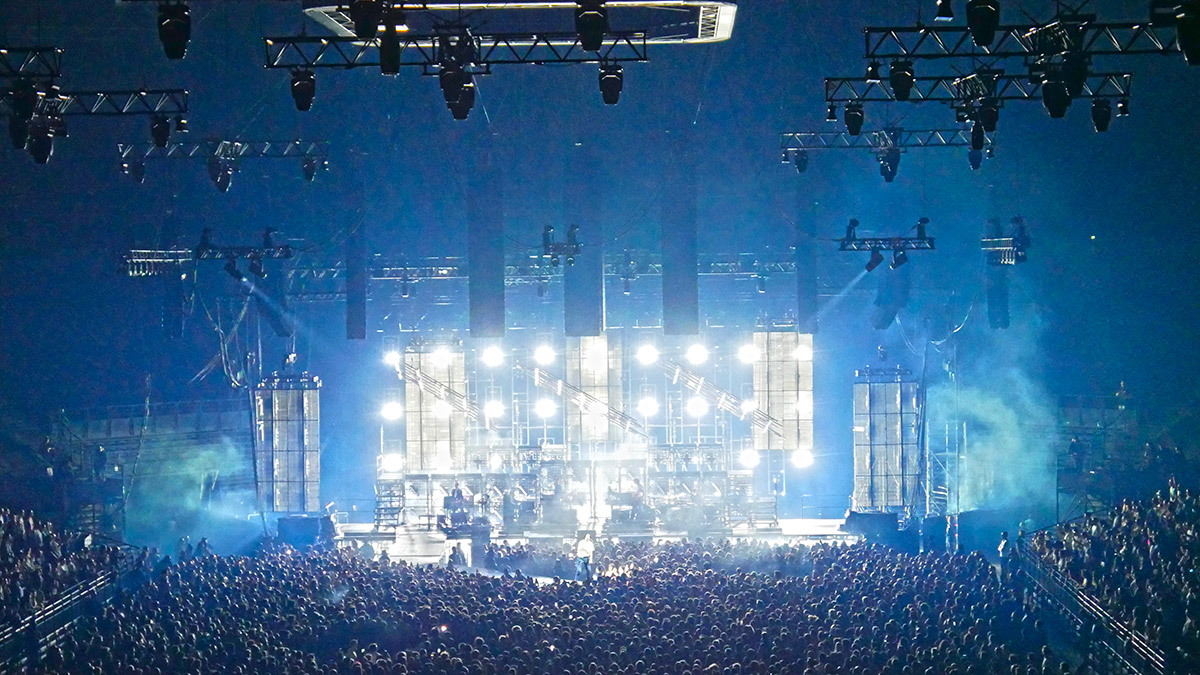
SLU : And what does the audience have to say?
Sylvain de Barbeyrac : When we do a left/right mix, it’s often a good sign that there are no comments from the audience at the end of the concert. In spatialised mode, people come up to us and tell us how good it sounds. People may not be aware of the reason they liked it, but they talk about it and notice a difference.
Unlike with stereo, we’ve tested and know that audiences have a much more coherent experience whether they’re sitting, standing or off-centre… it’s a real pleasure to know that they can hear the same mix wherever they are.
SLU : What are you planning for the next tour?
Sylvain de Barbeyrac : It always depends on the project. You can go immersive if the project calls for it. And it also depends on the artist. There are a lot of factors involved. It’s case by case. But personally, I’d be happy to do it.
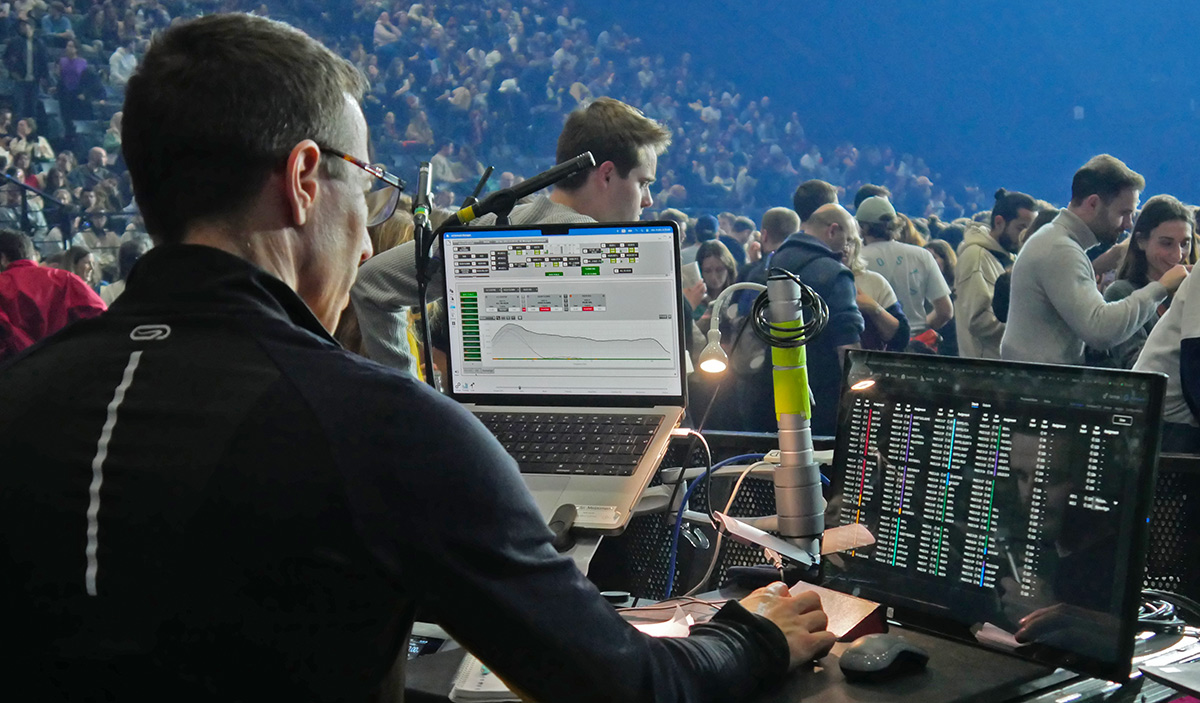
SLU : Do you see any limitations with the L-ISA system?
Vladimir Coulibre : I’d rather talk about constraints. We only went back to left/right once because it wasn’t possible to hang the L-ISA systems. It was no big deal and, what’s more, it allowed us to check that the setup worked well in stereo, as we were going to do a series of festivals.
Moving backstage, we meet Manu Mouton, Talent Boutique’s Technical Director for the tour, and Etienne Tisserand, who is in charge of system deployment. Of course, we take the opportunity to get their impressions.
SLU : As Technical Director for Talent Boutique, what are your thoughts on immersive L-ISA?
Manu Mouton : We had already done L-ISA on Christine and the Queen and with Vladimir. The fact that there’s good sound in 80% of the audience in immersive mode, compared with 20% for the left/right, means a lot to me. Even on the sides where you’re outside the immersive coverage, you still immediately feel that you’re inside the sound.
SLU : You’ve designed a very practical I-beam for flying the arrays and amp racks!
Manu Mouton : When we first set up for Christine and the Queens, we were a bit naive about the rig. We had grouped the rig on points with motors, and it blocked the front of the stage and put a lot of stress on the framework, while the amps were on the floor. When we said we were going to do it again with Lomepal, I had allocated a budget to deal with this problem.
We decided to put the amps behind the speakers and for that we created these I-beams, to avoid huge and long cable looms. We hoisted a distro box of 32 A three-phase and RJ45, and show up with the 2.60 m I-beam, that’s on the trolley with the LA-RAK IIs, and all the cabling already hanging from it. We pull it up a bit, mount the speakers and off we go.
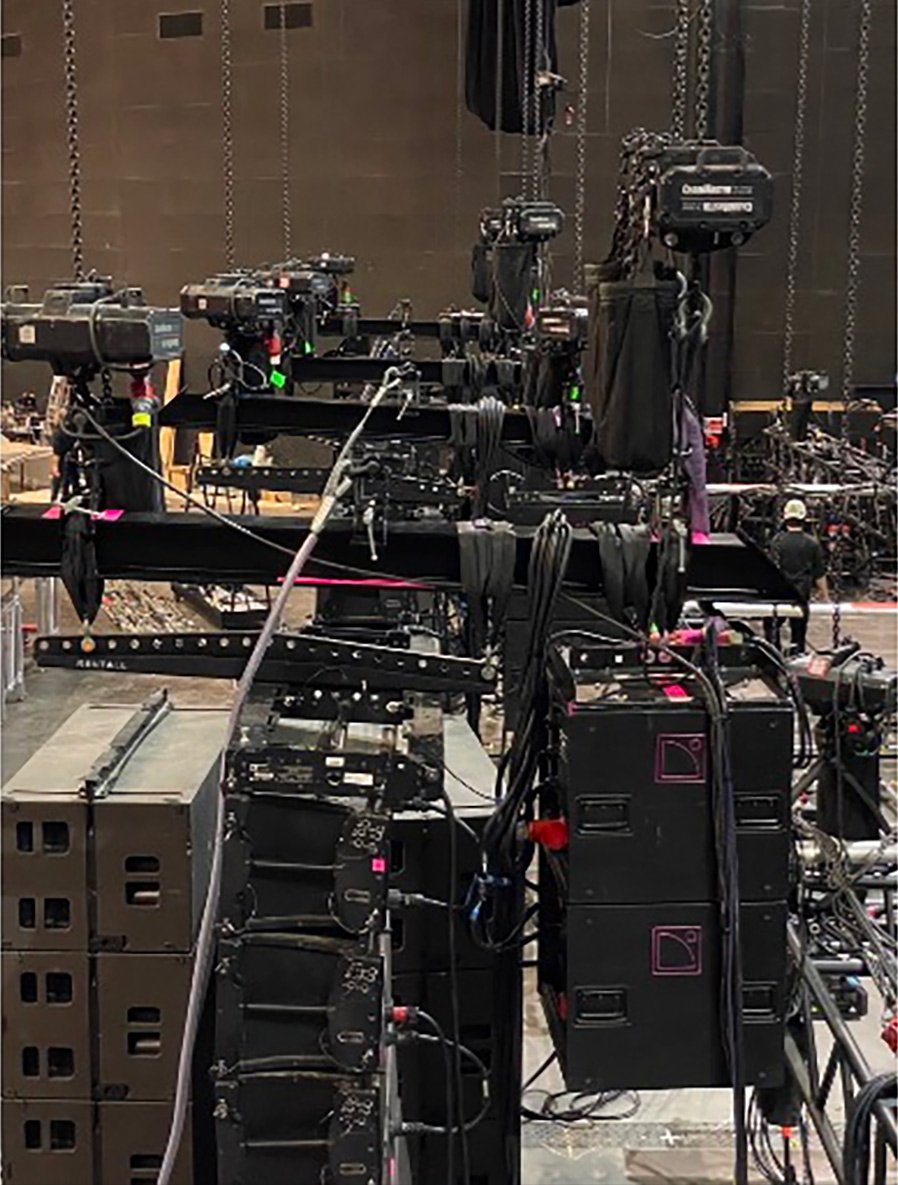
SLU : Thanks to this I-beam, the system looks pretty simple to install?
Etienne Tisserand : We roll the trolley under the rigging point, hook up the I-beam, which is ready with LA-RAK II, cabling and bumper. We then deploy the multicores on a grid, which is at the rear. Each array hangs down 14 m, with a 32 A three-phase, two RJ45 AVBs – primary and secondary – an XLR for analogue redundancy and a second XLR for the inclinometer on the bumper.
As we have 14 m of cable loop, we’re independent of the rear grid, which gives us peace of mind and allows us to install cables in any circumstances. The angles are pre-configured and the speaker systems go up by themselves. The A15 systems are also pre-assembled, so all you have to do is put the rack in the right place.
SLU : Isn’t having flown amps problematic, in the event of a failure?
Etienne Tisserand : This has never happened. The LA-RAKs don’t have an RCD, which means they can’t trip. You just need to make sure that the cabinets on the floor are fitted with a 30 mA circuit breaker.
SLU : Is it more complicated to transport and install?
Manu Mouton : Nowadays it’s the same as with a left/right system. As for rigging, with left/right, we have around ten electric chain hoists per side, and with L-ISA we have 22 in all. Practically the same number. In terms of deployment, we have 20% more boxes. Thanks to our I-beams, we can mount them more easily and in all directions, left, right, centre. If you’re blocked on one side, you can go up on the other, and it doesn’t block the proscenium or cut off access. You can ask anyone, L-ISA systems are no problem for anyone.
Etienne Tisserand : For the installation, there are three of us. We have a total of 216 speakers and 84 amps. With two people it would be complicated. We unload at 9:00 a.m. and by 11:30 a.m. the systems are flown. It takes an hour and a quarter to dismantle the arena-size kit. Here, it’s going to take longer. Access is difficult and we have a few more extra boxes.
SLU : What feedback have you received from venues?
Manu Mouton : We get a lot of positive feedback from the managers of venues that are known for being complicated, who tell us they’ve never heard their venue sound like that. With L-ISA, we don’t use any delays. At Tony Garnier Hall we just put a mono stack at the top of the central tier and no delay.
SLU : Finally, are there any limitations with L-ISA?
Manu Mouton : Since this immersive system has quite a visual impact, I asked that no more visual renderings be produced without integrating it. To validate its use, I prepared a file with numerous 3D views to explain what we were going to lose in terms of visual impact from the top tier. Everyone agreed and the lighting team handled it very well. The only debatable point is the rigging, which can be complex if you’re not prepared, but which we were able to adjust perfectly thanks to our I-beams…
Etienne Tisserand : It’s a great experience, a great moment, an impressive piece of kit. The central subs cluster weighs a whopping 2.7 tons and the largest speaker cable we use is only 6 metres long. When you start installing the system, people start asking questions. After a quick check, we set out all the speakers on the floor. When it’s ten o’clock, there’s a wall of speakers right in the middle of the room and that raises questions. You get the feeling that this is still something unusual.
216 loudspeakers for a uniform coverage over the whole arena without any delays, it’s an impressive feat. Even when you’re up against the wall of the highest tier of bleachers, 105 metres from the stage, Lomepal’s voice is clearly present in a mix that retains its full coherence.
With this latest test of its durability and adaptability on a 50-date tour of France, L-Acoustics is proving, with L-ISA and its unique approach to immersive sound, that spatialised sound is no more complex to manage and even easier to mix.
This is reflected in the enthusiasm of the team with whom we just spoke, and in the enjoyment of the audience listening to Lomepal’s music.



